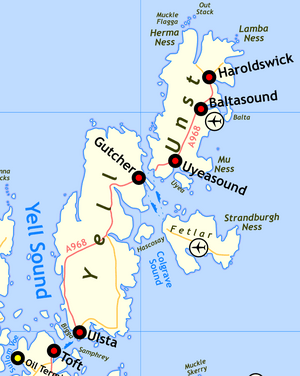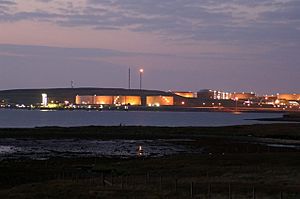Yell Sound facts for kids
Yell Sound is a narrow stretch of water, like a big channel, located in Shetland, Scotland. It runs between two main islands: Yell and Mainland, Shetland. This sound acts as a natural border, separating the Shetland Mainland from the northern islands. Many smaller islands are found within Yell Sound. A very important arm of the sound is Sullom Voe, which is home to a large oil terminal.
Ferries regularly cross Yell Sound to connect the islands. The sound can have strong tides and rough weather, making it a challenging place for boats. Because of this, there are many places where ships have sunk and several lighthouses to help guide vessels safely. Yell Sound is even mentioned in an old Viking story called the Orkneyinga saga. In the past, people used to collect kelp (a type of seaweed) here for a short time. Today, Commercial fishing is still a big part of the local economy. Part of Yell Sound is a special protected area called a Special Area of Conservation, set up to keep the local wildlife safe.
Contents
A Look Back in Time
The old Viking name for Yell Sound was Alasund. We're not entirely sure what this name means. The sound gets a quick mention in the Orkneyinga saga, a famous story from the Middle Ages. It tells us:
- "Earl Rögnvald... and the chiefs Sölmond and Jón with him... arrived at Hjaltland (Shetland) about the middle of Summer... Strong and contrary winds sprung up, and they brought their ships to Alasund (Yell Sound), and went a-feasting over the country."
This shows that even long ago, Yell Sound was a known place for ships to find shelter.
Islands of Yell Sound
The northern entrance to Yell Sound is protected by a group of small islands. These islands are just north of the Point of Fethland, which is the most northern part of Northmavine on the Shetland Mainland. The biggest of these islands is Gruney. North of Gruney, there's a small group of reefs and rocky islets called the Ramna Stacks.
Yell island itself is to the east of the sound. South of a headland called Nev of Stuis on Yell, you'll find more islands in the sound. These include Sweinna Stack, Holm of West Sandwick, Muckle Holm, and Little Holm. Yell Sound gets narrower between Mio Ness on the Mainland and the southern part of Yell. In this narrower section, you'll see islands like Bigga, Brother Isle, Lamba, Orfasay, Little Roe, Samphrey and Uynarey.
Further south, past Firth Ness, the sound widens again. Here, you can find islands such as Fish Holm, Linga, Setter Holm, Sinna Skerry, and Wether Holm. The eastern entrance to the sound is between Heoga Ness on Yell and Lunna Ness on the Mainland. Near Heoga Ness are Gold Skerry, Green Holm and Neapback Skerries. Near Lunna Ness are Lunna Holm and Sand Skerry.
Exploring the Inlets
Yell Sound has many large bays and inlets branching off it. On the Yell side, the Whale Firth is about 6 kilometers (3.7 miles) long and joins the sound at Nev of Stuis. Southladie Voe is a few miles further south on the western Yell coast. The large bay of Hamna Voe is at the southern end of Yell. A smaller inlet, Burra Voe, is nearby, close to the village of Burravoe.
On the northern Mainland side of the sound, the village of North Roe sits on the shores of another Burra Voe. South of there is a larger inlet called Colla Firth. Next are Ollaberry Bay, Gluss Voe, and Sullom Voe. Sullom Voe is a very important inlet and, at 12 kilometers (7.5 miles), it's the longest of Shetland's many "voes" (which means "bay" in Old Norse). It's home to the Sullom Voe Terminal, which handles oil. Sullom Voe ends at a very narrow strip of land called Mavis Grind, which separates the North Sea from the Atlantic Ocean.
Even further south, you'll find more inlets like Orka Voe, Tofts Voe, Firths Voe, Swinister Voe, Dales Voe, another Colla Firth, Swining Voe, Lumna Voe, and a second, smaller Hamna Voe.
Ferry Journeys

The ferry that connects the Mainland to Yell (and then to Unst and Fetlar) travels between Toft on the Mainland and Ulsta on Yell. This route passes between the islands of Samphrey to the east and Bigga to the north. The ferries used today are called Daggri and Dagalien. They are roll-on-roll-off ferries, meaning cars and trucks can drive straight onto them. These ferries have been operated by the Shetland Islands Council since 2004.
Built in Gdańsk, each ferry is about 65 meters (213 feet) long. They can carry up to 95 passengers and 31 cars or 4 trucks. These modern boats are much bigger than the old ones, which has made travel to the northern islands much easier. The crossing takes about 20 minutes, and ferries run every half hour.
The first regular ferry service to the North Isles started in 1839 with a boat called the Janet. Over the years, other steamers like the Chieftain's Bride and the SS Lady Ambrosine took over. The Earl of Zetland, an iron steamer, began a twice-weekly service from Lerwick to Unst, stopping at various places in Yell Sound. This ferry even survived two attacks by enemy aircraft during World War 2! A larger Earl of Zetland was introduced after 1945, which was popular with summer visitors.
Shipwrecks and Dangers
Sailing in Yell Sound can be tricky due to strong currents and bad weather. Many ships have been wrecked or had dangerous incidents here. In 1832, a fishing boat from Samphrey was caught in a storm and blown all the way to Norway! Luckily, the crew returned safely to Shetland the next spring, much to the relief of their families who thought they had drowned.
The wooden fishing boat Ellen sank on the Rumble Rock (between Samphrey and Orfasay) in 1896. In 1904, the trawler Ibis was also wrecked at the same spot during a snowstorm, but its crew was saved by another trawler. In 1914, the steamer Robert Lea, which was 50.2 meters (165 feet) long, ran aground near Brother Isle. Thankfully, no lives were lost. In 1992, the wreck was found underwater. The fishing boat Morning Star sank near Muckle Holm lighthouse after a fire in its engine room. In 1983, the Royal Navy found an unknown shipwreck while clearing old bombs from Little Holm.
Guiding Lights: Lighthouses
Several lighthouses, managed by the Northern Lighthouse Board, help guide ships safely through Yell Sound. At the northern end, you'll find Bagi Stack Lighthouse on Yell, and Gruney and Point of Fethaland to the west. To the south, the outermost light is at Lunna Holm Lighthouse.
Inside the sound, from north to south, there are lights at Muckle Holm Lighthouse, Little Holm Lighthouse, Lamba South Lighthouse, Outer Skerry Lighthouse, Brother Isle Lighthouse, Ness of Sound Lighthouse, Rumble Rock Lighthouse (since 2001), and another light on the Mainland. These lights are crucial for safe navigation.
Working in the Sound
The northern part of Yell Sound is a good place for fishing. People catch haddock, herring, and crabs here. The inner sound has areas where scallops are harvested, and there are also various fish and shellfish farms.
In the late 1800s, people briefly harvested large amounts of seaweed, like wrack and tangle, from the sound. This seaweed was used to make chemicals like iodine and bromine. Visitors at the time were amazed by the many small fires burning along the shores as people processed the kelp.
Today, Yell Sound isn't used much for fun activities like boating, possibly because of the large number of oil tankers going to and from Sullom Voe. The entire sound is controlled by the Shetland Islands Council's Ports and Harbours authority, as it's a main shipping channel.
Amazing Wildlife
Part of Yell Sound is a Special Area of Conservation (SAC). This is mainly because of the large number of otters living here. Shetland has one of the highest populations of otters in Europe, and up to 2% of all British otters might live in this area! The low, peaty coastlines provide easy access to fresh water, and there are lots of seaweed beds in the sea, plus many places for otters to make their homes.
There's also a significant population of common seals, with the local group making up over 1% of the UK population. Sullom Voe itself is a separate SAC, protected because of its many large, shallow inlets, bays, coastal reefs, and lagoons.
You can find beds of horse mussels both within Sullom Voe and along the Mainland coast near Colla Firth. Large sea creatures like harbour porpoises, minke whales, and killer whales are often seen in the inner sound. There are also many different types of seabirds, divers, and ducks, including eider ducks, that breed here.




